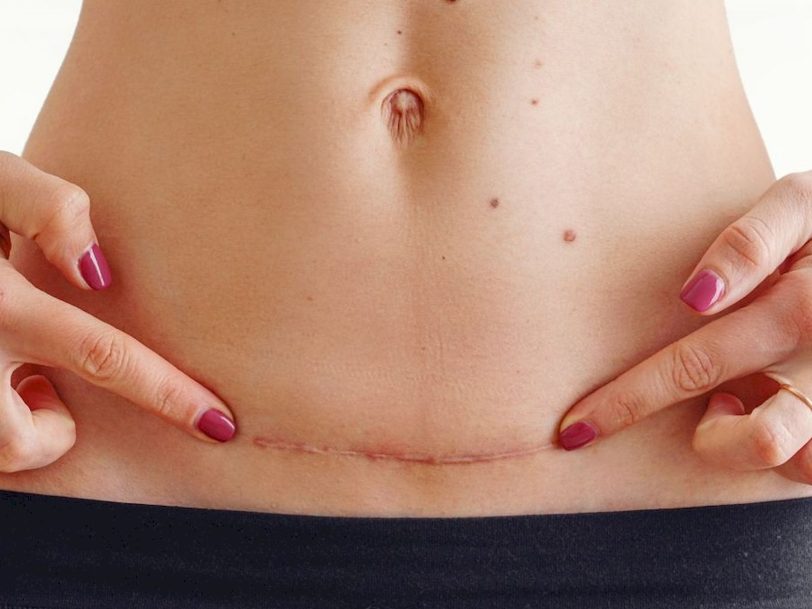When does the c section scar go away?

To begin the care of a cesarean section scar, it is essential to have a professional assessment who tells us when it is time to start treating it. Avoiding possible adhesions of the tissues, improving its appearance, recovering sensitivity or improving hypersensitivity are some of the benefits.
Healing from major surgery such as a cesarean section is slow and can last up to two years. And it is that, like any other scar, in the remodeling process they generate a pathological tissue.
When the physiotherapist says “pathological tissue” she means that a scar always creates a dysfunction in the body to a greater or lesser degree, and with greater or lesser repercussions in the long term, since this will depend on various factors such as: hereditary, epigenetic, acquired…
In a cesarean section surgery up to 7 layers are sectioned (skin, fat, fascia, abdominal muscles, peritoneum, uterus and amniotic sac) which are then sewn in the opposite direction. It is always advisable to treat the scar due to the high manifestation of type III collagen, initially, which is later transformed into type I collagen, which generates more tension in the structure and can cause so-called ‘adhesions’ (collagen is one of the main proteins in healing processes, in addition to fibrins, fibronectins, proteoglycans, glycosaminoglycans, etc.).
It is precisely these adhesions that cause the so-called “scar tissue bands” and the causes of possible complications, since they make the layers that are sectioned (mentioned above), stick to each other and lose the necessary slippage for a good performance.
How to treat a cesarean section scar?
To prevent this from happening internally, and also to achieve aesthetic blurring of the scar as much as possible, there are a series of recommended treatments and care, which, are as follows:
- Diathermy: radiofrequency that is used from the first days, it is a painless treatment that helps cell regeneration and through tissue revascularization reduces inflammation and edema. It is the queen of immediate treatment in cesarean sections, due to the good results and painless application.
- Myofascial induction: global treatment where through manual techniques we achieve better sliding between planes (layers) and decrease tissue restriction.
- Neuromodulation: for work on sensitivity and pain in the area and recovery of the abdominal nerves.
- Dry needling: for treatment of abdominal muscles and caesarean section.
- Suction cups: to detach the planes and create a “suction” effect
- Manual scar removal maneuvers.
- Therapeutic exercise so that, through postural correction, pelvic floor strengthening, abdominal work, etc… we get the scar to accept different tensions and not look for that shortening due to scarring.
When to start treating the cesarean section scar?
The best thing is that they come as soon as possible for an assessment and that a professional guide them on when to start and what treatment to carry out. We understand that quarantine is always the guide for mothers to start any type of activity after childbirth, and that is the case in general terms, but, in the case of cesarean section scar care, experts recommend that as soon as possible start treating better.
The times that are considered, therefore, advisable to start the treatment are the following: You can start (if possible) with diathermy, but this will be decided according to the suture method. If it is with staples, when they are removed, that is, after 10-12 days you can start. If they suture intradermally, treatment could be started even earlier, because the entire abdomen is worked on, not just the area of the scar.
We must remember that skin healing is always a slow process and that it consists of several phases. At first it is normal for the scar to be red and inflamed and even cause some discomfort, itching… but as time goes by it will acquire a more homogeneous color and the discomfort will disappear.
What can we do to take care of the scar at home (once the stitches have been removed)? Experts recommend washing it with soap and water, keeping it well hydrated, for example, using the same anti-stretch mark cream you used during pregnancy, protecting it from rubbing against your clothes, and giving yourself daily massages to prevent adhesions.
It is a process in which you have to be patient for your recovery, but, above all, you have to know that the duration of treatment depends on each person because the type of scarring is different in each one. Normally, about 8-10 sessions are needed and they are usually spaced out over time (treatment is not performed every day) so it takes a few months to recover. It is not recommended to exercise until 6-8 months, or at least if it is not supervised, so it is also important that the figure of the physiotherapist or health professional specialized in postpartum accompanies this incorporation into their sporting life.